6 Preparations Before Switching to Raw Food (Transition)
After age 50 or if you have health problems, get a physical examination every X years. As a comparison, get one before switching to raw food—it's YOUR life!
Table of contents

Summary
Most often, the people who decide to switch to a raw food diet either have a serious illness or lead a very healthy lifestyle. Those who are seriously ill are confronted with death. This commands their entire attention (consciousness).
You should know your personal numbers for the values described below and discuss these with a physician not only to have a comparison, but also to uncover any unknown physical or psychological problems. If you are anorexic, your doctor should work with you during the transition.
| In the case of lifestyle diseases, a raw food diet can help very quickly and heal the cause. But not every sickness that has the same symptoms also has the same causes. This is why no one can predict a priori if a person will be cured or will improve, as is often claimed. Several typical lifestyle diseases have specific indications that you should watch for. |
If in the course of the tests, your doctor discovers that you have a serious illness, you have won time, and the problem can be solved sooner.
For example, essential hypertension (also called primary hypertension or idiopathic hypertension) disappears in many cases after only a few days of eating right as long as you stick to your diet. But usually physicians deny this because they don't know enough about nutrition—but they still have a strong opinion on the subject.
If you are already sick, you should only make the transition if you are in a position to follow the new diet closely. Avoid poor nutrition by doing thorough research on the subject.
A strict vegan raw food diet without dairy or grain products is highly recommended for the beginning—until you get to know how your body reacts to certain foods. In the case of strong reactions, you should find a doctor to work with who specializes in nutrition.
1. Steps to take before switching to a raw food diet
It is unlikely that active young people who are full of life and more or less follow the mainstream society without concern would have an awareness of a healthy lifestyle.
For people, damage is not visible or detectable when they are young either and only appears much later. Just compare the skin of smokers and nonsmokers in their “best years.”
Today's lifestyle causes people to get lifestyle diseases at an early age—even if these sometimes remain undetected.
I recommend that you have a physical examination that includes several tests so that the difference between your values before and after eating a raw food diet for some time can be established not only subjectively, but also objectively.
Tests
At the very least, you should request a urine test and get your blood work done. This will also serve to uncover any undetected diseases. I would especially advise you to do this if you haven't had a physical examination for many years or you don't have a copy of your (most recent) values.
If the examination uncovers something, well it is much easier to treat a disease that is detected early than if the pain and symptoms are already present. You are the one who has to decide what to do if there is a positive result. Seek the advice of a physician, but don't let them simply give you medications. Usually, though, they won't have any alternatives.
You can gain a lot of time by voluntarily having diagnostic tests done. But make sure to avoid “straw treatments.”
With many diseases, a strict vegan raw food diet can work wonders.
Results like these can be seen in a number of firsthand reports, not only in mine. But if you find out that you have a particular disease, you still shouldn't rush into eating a raw food diet or blindly follow your doctor's instructions.
In such a case, the best thing to do is to get a second opinion from a doctor who has practical experience in using raw food as treatment. And you also have to decide for yourself if you want to eat a strict 100 % raw food diet and if you are capable of doing so.
Only people who have the mental strength and determination will succeed on this path in a society that doesn't understand it. Are you emotionally unattached to the opinions that others have and do you have a strong will? Without the positive attitude of your brain and limbic system, you won't be able to stick to a raw food diet in the long term. See also emotion and instinctive behavior.

2. What tests your doctor should do
It is advisable that you have a record of your results that includes an assessment of your overall health situation. Your physician will suggest various tests based on your age, medical history, and health condition.
2.1. Urine test
A urine test (previously uroscopy) at the doctor's office is usually based on what is called a midstream specimen. Depending on the test, the first morning urine or the second morning urine will be used.
Every few months or if you aren't feeling well (physical illness), the most important parameters can be tested at home with urine from any time of the day.
| Common parameters include blood/erythrocytes/hemoglobin, glucose, ketones, ascorbic acid, protein, leucocytes, nitrites, specific weight, pH, bilirubin, and urobilinogen. The values will be approximate. |
Simpler urine test strips (e.g., Bayer Labstix, Mission URS-10) show the following: protein, sugar, nitrite, ketones, and blood. These parameters should only show the first color, no matter what type of urine is used.
The Combur 10 Test urine test
Most urine test strips test for these parameters and, very important, also for the pH value.
The pH scale is logarithmic. This means that there is a factor of 10 between the pH values of 6 and 7. For example, the pH value of 5 is a factor of 100 lower than the pH value of 7.
In general, protein-rich foods make your pH level more acidic, whereas vegetables cause it to move toward the alkaline side. Your pH value is most influenced by what you eat, but physical activity, metabolic disorders, and cancer also play a role.
The pH value moves toward the alkaline range shortly after lunch.
I use the Combur 10 Test. These urine test strips also show the specific weight with the abbreviation SG (spezifisches Gewicht, SG), unlike the Combur 9 Test. You should make sure that you drink enough as this will help to decrease your values.
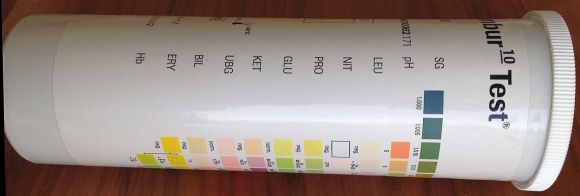
The Combur 10 Test urine test strips show results for specific weight (density), pH, leucocytes, nitrites, protein, glucose, ketones, urobilinogen, bilirubin, and red blood cells (erythrocytes) as microhematuria or blood in the urine (lowest field Hb for hemoglobin).
On a raw food diet, some of these values can be achieved without drinking extra water because the food itself contains water. However, older people, in particular, should drink about an extra liter of water or herbal tea daily, even if they don't feel thirsty. The amount of urine excreted each day is critical.
This amount can be easily determined using a measuring cup—and your physician can also say something about your bladder function if the individual amounts are too small. In the best case, this will mean that you have an overactive bladder (irritable bladder).
Excreting 1–2.5 liters per 24 hours would be ideal. The specific weight (density) is actually very important and should ideally be between 1.010–1.015 g/L.
Common parameters measured by urine test strips include blood/erythrocytes/hemoglobin, glucose, ketones, ascorbic acid, protein, leucocytes, nitrites, specific weight, pH, bilirubin, and urobilinogen.
If you think you have an infection, especially a urinary tract infection (UTI), your physician will also do tests for bacteria or determine the bacterial count with an uricult test (Uricult® Roche) or a Punctomed Urin-Test® (urine test) from Dolorgiet. If the test is positive, your physician will have a urine culture done and test the sensitivity of the bacteria to various antibiotics in order to determine what means would be effective. This is called an antibiogram.
The color and composition of urine, urine sediments
The color and composition of urine can also be important. Depending on the disease, the urine may be light, dark, red, white, or black. Urine can also appear foamy. Color and foam are visible to the naked eye. A physician can also have a urine sediment test done. The urine should be as watery and light yellow as possible, but certain foods will also change it. If you eat red beets, the color will show up in your urine.
Shortly after eating asparagus (garden asparagus), about half of people will have urine that smells unusual. This isn't caused by the diuretic amino acid aspartic acid (Asp or D), or by arginine or tyrosine. According to the Römpp-Lexikon Lebensmittelchemie (Römpp lexicon of food chemistry), the smell is formed by metabolites such as S-methyl thioacrylate and its methanthiol addition product S-methyl 3-(methylthio)thiopropionate. Not everyone converts it this way. Incidentally, aspartic acid serves as a protein building block used for the formation of white blood cells.
Urine sediment can also be used to determine the properties and bacteria listed above. This is important information. Poor values indicate various disorders such as circulatory disorders of the kidneys, inflammations, and metabolic disorders (e.g., diabetes and blood production and blood degradation disorders).
2.2. Complete blood count
At the very least, your doctor should know what your most important blood values are, from a blood count or complete blood count. This requires that blood be drawn (venipuncture) from a vein.
Use a needle with a diameter of 0.6 mm and a tourniquet
I ask my doctor to use a needle with a diameter of 0.6 mm and a tourniquet so that my veins suffer as little as possible. Then the surface area is only 0.28 mm2 in comparison to 0.64 mm2 with the very common 0.9 mm diameter needles. Doctors who care about the well-being of their patients will use thin needles. But as a result of the special edge on the head of the needle, the entire circular area is not affected by this size difference. The difference is therefore smaller than as described above.
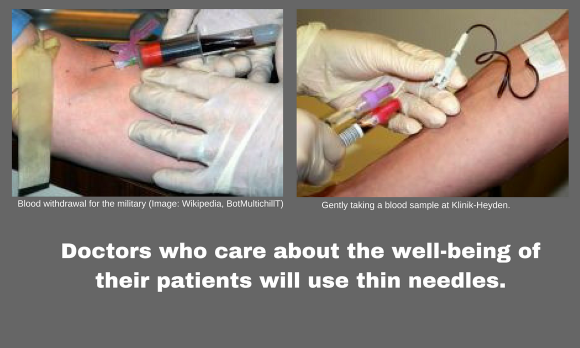
With the determination of the erythrocyte sedimentation rate (ESR or sedimentation rate) that follows, inflammations, infections, rheumatic diseases, signs of cancer, and severe anemia can be detected. Early detection and, if need be, treatment can help to avoid more serious problems.
Other common testing methods include coagulation time and prothrombin time (also called ProTime INR and PT/INR)—using citrated blood. The blood that is withdrawn is also used to test the red and white blood cells (hematology).
The determination of individual values such as hemoglobin, hematocrit (volume percentage of red blood cells in the blood), and leucocytes or the summary of the individual values in a complete blood count can uncover numerous problems such as low immunity, infections, anemia, and dehydration. See also information on the differential blood count.
The determination of biological electrolytes in the blood (sodium, chloride, potassium, calcium, magnesium, and phosphate) provides more information about kidney function. If the potassium levels are too low, this can, for example, cause muscle weakness, paralyses, or in the case of individuals with heart disease, also heart rhythm disturbances.
Other elements
Sometimes, the blood should also be tested for other elements. The level of iron (ferrum) in the blood is particularly important for women who are menstruating in order to rule out a general iron deficiency as people often have this without having any symptoms. Either way, you should get this checked.
It is very seldom that certain elements or other substances are absorbed inadequately—no matter if you are eating cooked or raw foods. If this does become a question, you should have these values tested as well.
These include, for example, the levels of copper, zinc, and selenium in your blood. The tests for these are ten times more expensive than the clinical chemistry tests listed above.
Get your lipid values checked as well (cholesterol, HDL cholesterol, LDL cholesterol, and triglycerides).
I believe that it is very important to get vitamin B12 checked (cobalamin) and not just the overall status of vitamin B12. The earliest marker is the value of holotranscobalamin in serum. At a later point in time, the methylmalonic acid (MMA) and homocysteine values can increase. I discuss this in detail in another section, but here is a little information on the subject:
Wikipedia (German version) April 2014: Elevated homocysteine values are connected to alcohol consumption, smoking, frequent coffee drinking, lack of movement, and being overweight. ... Homocysteine can cause direct toxic damage to vessel walls and, in a variety of ways, lead to thrombophilia.
Patients who have coronary heart disease have an increased risk of cardiovascular events when their homocysteine levels are even slightly elevated, whereas the available data in regards to completely healthy individuals is inconsistent. Multiple studies have shown that homocysteine levels of over 15 µmol/L increases the risk. ... Elevated homocysteine levels are a risk factor for the development of all stages of muscular degeneration.
Your physician should also have your blood sugar level tested (with an empty stomach). Pharmacists can test this by pricking your finger or using more modern methods that don't require pricking.
If your blood sugar value is poor or borderline, you should seek medical advice and have a medical examination done. Normal values can be found below.
Prostate-specific antigen
If you suspect diabetes, you should also have your glycated hemoglobin checked. A whole blood sample with EDTA (ethylenediaminetetraacetic acid) should be used to perform this test. Further considerations related to this topic can be found below as it is important that diabetes be diagnosed as early as possible. That is why I have also included a section on this lifestyle disease below.
If you are a man over 50, the PSA value and PSA quotient are very important. PSA stands for prostate-specific antigen, and if possible, it should be under two to four—depending on your age. And the PSA quotient or rather the ratio of free PSA (FPSA) to total PSA should be above 0.19.
On Wikipedia, reservations are expressed regarding the PSA value, specifically that the value doesn't need to be tested.
I don't share this opinion, not even if a man has a value that is too high after truly changing his diet to one that doesn't include dairy products.
It is possible that it is bacterial prostatitis and therefore acute prostatitis that can be treated. In particular, if CP/CPPS (category III) is suspected, you can see—with the link to prostatitis—the problems of medical treatment or rather the lack of success. See CP/CPPS (chronic prostatitis/chronic pelvic pain syndrome).

A poor value is a warning signal and also a possible measurement of success and motivation or reason to change your eating habits.
On November 23, 2000, I had a PSA value of 18.4 with a very poor Q-value of 0.04. After taking antibiotics for several months, with a PSA of 7.4, the Q-value was still 0.08. That was the end of the medical treatment, or rather my urologist then recommended a radical prostatectomy, which is the removal of the entire prostate gland, the seminal vesicles, and the vas deferens. With all of its risks. I decided not to see this doctor again and only had my values checked regularly.
On May 11, 2001, after discussing the situation with my partner, who is now my wife, I began to eat a strict raw food diet without dairy products.
The results: July 2001—4.64/0.13, February 2002—3.3/0.19. The urologist denied that this had anything to do with the changes I had made with my diet.
I have to assume that he doesn't have any knowledge about the broccoli treatment from Prof. Ibrahim Adnan Saracoglu, Vienna University of Technology (TU). See also this link and read more about broccoli.
If you have poor values, you will benefit most from a vegan raw food diet (no dairy products). See also this book review (currently only in German) on the harmful effects of milk. And also important for women, if you feel that you have less energy or your weight has recently changed dramatically although your lifestyle has been the same, you should have your blood tested for cancer markers.
Perhaps your physician will recommend additional blood tests. In the case of a possible cardiac or pulmonary infarction, your physician may have the enzyme LDH (lactate dehydrogenase), GOT (AST), and CK (creatine kinase) checked.
Liver values and systemic mycoses
Liver values: the activity of the enzymes GPT (glutamate-pyruvate transaminase), GOT (glutamic oxaloacetic transaminase) as it was formally called, today aspartate transferase (AST, AspAT, ASAT, or AAT), and gamma-GT (Gamma-glutamyl transpeptidase, γ-glutamyl transferase, GGT, or GGTP) provide information about the condition of the liver.
Elevated γ-glutamyl transferase values are relatively specific to liver diseases. In the case of acute or chronic liver diseases, damage to the liver, or cardiac or pulmonary infarction (pulmonary embolism), the GOT or AST value is significantly higher.
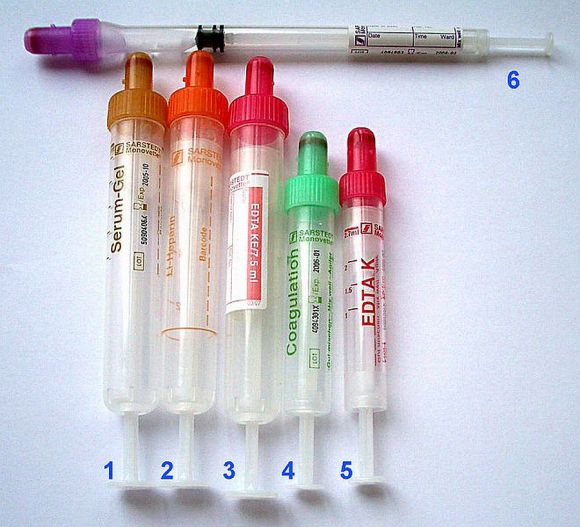
Blood collection tubes with color coding in accordance with EN 14820 for the specific tests: (1) Serum-gel tube (brown), (2) Heparintube (orange), (3) EDTA tube (red, large), (4) Citrate clot activator tube (green), (5) EDTA tube (red, small) und (6) ESR (citrate) tube (purple). Image: Wikipedia from HoRaMi, GFDL.
An elevated gamma-GT concentration points to liver disease (hepatitis).
This includes systemic mycoses (mycosis, invasive mycoses) and candidiasis (candida albicans, yeast fungus, yeast). These types of fungi thrive on foods that are rich in simple carbohydrates, and they multiply accordingly. An unhealthy balance between bacteria and fungi is rarely the case with the diseases mentioned. Systemic mycoses requires a severely weakened body.
It is somewhat more common that there is an overgrowth of fungi in the intestine, though a certain level of fungal flora is normal and necessary. A healthy diet is usually enough to regulate this, but it can take more time than medical treatment.
At any rate, if you suffer from cardiac arrhythmia (irregular heart beat) or frequently have diarrhea (diarrhoea) or drum belly (bloating, tympanites, metorism), serological testing may be beneficial.
If you have an overgrowth of intestinal bacteria, products that act only in the intestine and not in the entire body are very safe to use. It is only very seldom that an antifungal treatment that acts in the entire body is necessary—and this is toxic.
The HA or hemagglutination assay looks for Immunoglobin M (IgM). These antibodies are only present during an illness and for a few days thereafter. Immunoelectrophoresis, consisting of gel electophoresis of proteins and immunodiffusion, detects G-type antibodies (IgG, gamma globin)
These antibodies are present in the blood for about a month after an infection. If one of these tests is positive, the cause should be determined via a blood culture or antibody detection test; however, in the case of a fungal infestation, this is very unclear.
If it is not a “normal infection,” you should cut out sweet fruits for 10–20 days and get a prescription for one of the safe oral medications that work against fungus in the intestinal tract.
These contain active ingredients such as "nystat.." (older), "amphoteric.." B, or "natamyc..". I have identified this course of treatment as safe because these molecules are so large that they aren't absorbed into the body. But if you would like more information, please read the links.
However, if the fungi have established themselves as parasites (parasitism) in other organs, for example, in the lungs, then infusions are appropriate. These often have severe side effects and should only be used in the most serious cases.
Note: I am not recommending all of these tests because you are planning to change your diet, but rather so that you know what your health condition is before you make lifestyle changes. Only by doing this will you be able to make an objective comparison at a later point in time.
I want you to feel confident about your new diet when others question its value. You should also have confidence if you develop any disease symptoms that are a result of your previous lifestyle.
Other authors often write about detox symptoms that occur when they make major changes to their previously poor lifestyle. Neither I nor others I have spoken with experienced these when switching to a raw food diet. Your doctor should clarify any absorption disorders such as hypovitaminosis (vitamin deficiency), which are rare genetic or acquired disorders.
2.3. Hair mineral analysis
Hair analyses are used primarily to determine consumption of drugs, narcotics, or drug products. In addition to substances such as cannabis, cocaine, ecstasy, and heroin, doping substances such as anabolic steroids and nandolone can be detected. Even alcohol abuse or alcoholism can be identified via the metabolic product ethyl glucuronide (ETG).
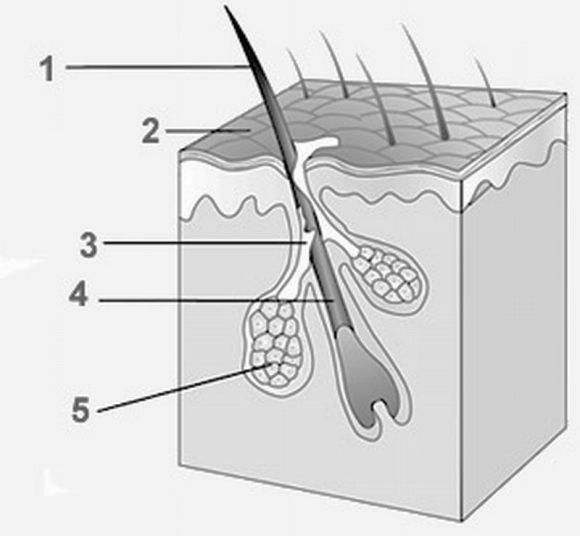 | Schematic structure of a body hairs: 1 = Hair |
This type of analysis can also be a helpful way to detect a previous lack of trace elements. The current amounts can be seen in a blood and urine mineral analysis.
As well as trace elements, a hair mineral analysis can measure mineral nutrients and heavy metals, but large imprecision errors do occur. For this reason, the analysis is particularly suitable for groups of people who, for example, have been exposed to a common toxin (in their career, building, or place of residence). The analysis is not used to determine a vitamin deficiency.
Heavy metal contamination often leads to a significant trace element deficiency
Don't get a hair analysis done based on what you hear in advertising and PR (public relations), but only if your physician believes that it is necessary.
Heavy metal contamination often leads to a significant trace element deficiency.
Information from a show on WDR (German public television station) on March 12, 2001: in contrast to blood and urine testing, which only provide a snapshot in time, hair contains information on what has been happening in your body in recent months.
For a DNA analysis, for example, for parental testing (“paternity test”), only a hair with the root attached can be used because this is the only place with cells containing material that can be used in an analysis.
A gram of hair (one rounded tablespoon) is enough to obtain information about metabolic processes in the human body. And hair extraction is a simple, noninvasive procedure.
The hair directly at the nape of your neck work best for this analysis as it has been damaged the least by external influences. Permed hair can't be used, and if you use hair that is colored or has been washed frequently, the results won't be as accurate.
In Switzerland, for example, the company Baxamed, Hauptstrasse 4, 4102 Binningen, performs hair mineral analyses that test for mineral nutrients and heavy metals. It takes about 30 days and costs 120 € (2015). The analysis set can be ordered via info@baxamed.com.
3. Metabolic types and other diets
This section is meant to be an example of how people can get on the wrong track and neglect to take the important steps that are necessary for a balanced diet. If you have taken these important steps, then why not, if the nutritional balance is right for your body and you aren't getting “too much.” Only your wallet will suffer. In English, this is called metabolic typing.
Clever businesspeople persuade people to eat in a certain way. Compare here the diet based on the four blood types, called the blood type diet, with the diets below. A person with a good intellectual capacity will realize immediately that they would have to eat very differently on each of these types of diets ...
The same goes for the five element diet, macrobiotic diet, food combining diets such as the Hay Diet, the alkaline diet, Chinese food therapy, TCM, the anthroposophic approach to nutrition, the Ayurvedic diet, whole foods diet, Mazdaznan diet, Waerland diet plan, Schnitzer diet, vegetarian diet, and vegan diet.
And particular fad diets with contradictory nutrition advice such as the Atkins diet, low-carb diet, and numerous offshoots of these are popular because they are based on people's favorite foods. In the long term, these are detrimental to your health.
If you were to take all of these views into account, you wouldn't be able to eat anything at all. And this is only a short list of the many diets out there—here is a more comprehensive list of diets on Wikipedia. Avoidance behaviors and trendy foods should also be questioned.
Macrobiotic diet
Some basic macrobiotic ingredients.
The nutrition scientist Claus Leitzmann: Given the very limited number of foods permitted, the macrobiotic diet developed by Ohsawa is one of the most controversial diets. It is problematic from a nutritional point of view and given the small amount of fluids, it can lead to serious health problems. In the case of a pure grains diet, which is particularly recommended for those suffering from illnesses, serious deficiencies must be expected.

“A macrobiotic diet as recommended by Kushi can especially lead to problems for children since the consumption of fat, calcium, iron, and vitamins D, B2, and B12 is too low.”
The metabolic type diet
As an example, here is a little more about the metabolic type diet. I can't judge what the consequences of a diet based on the four metabolic types are. But I see it more as a gimmick than something of significance.
Here is the translation of the original script of a show on WDR: People can basically be divided into four different metabolic types: the normal metabolic type—at 10 percent, this group is only a minority—and the slow, fast, and mixed metabolic types.
If your metabolic processes are slower, than you feel tired and lack energy. Toxins can easily accumulate in your body. Migraines and sleeping problems are the norm. This metabolic type is found, in particular, in women over 30.
In contrast, people with a fast metabolism are often overly nervous and experience fear and aggression. Older men often have this type.
A diet customized to the individual metabolic types—so goes the theory behind the diet—should work against all of these problems. People who have slow metabolic types should strictly cut out dairy products for about three months.
More importantly, it is very important that people with this metabolic type drastically reduce the proportion of fat in their diet. Incidentally, up to 45 % of the population is believed to have the slow metabolic type.
The types are determined by the levels of calcium, magnesium, sodium, and potassium in the body. Again from the script of the WDR show: In order for calcium to act, the body needs the vitamins A, C, D, and E. However, vitamin D is a 'rival' of magnesium, which in turn requires the presence of B6.
And continuing: Calcium and iron promote the metabolism of phosphate, but also 'drive out' the element manganese, which decreases copper levels.
I naturally don't agree with the next part: In contrast, people who have fast metabolic types may consume dairy products and fat ... It might therefore be the case that the recommendation given to an older overweight gentleman is to eat a lot of cake with whipped cream and rich sauces.

For me, this sentence places the entire assignment scheme into question. The company Biometa claimed that those who have fast metabolic types, about 15 % of the population, therefore have a tendency to be overweight and have high blood pressure.
In Germany, various pharmacies offer metabolic typing, but the prices vary greatly, and insurance companies usually don't cover the costs.
If you decide to get tested, it is worthwhile to ask multiple providers how much they charge for a certain number of tests as the number is an important price criterion. For example, in Germany, for 120 euros (2015), Biometa provided a graphic display of the laboratory values for their analysis type A with 29 elements, 12 of which are toxic metals.
A version with extensive comments and a (conventional) diet plan costs more than double this. Since the computer prepares this automatically, I believe that they are asking too much. In fact, I consider the whole thing to be a “business scheme.”
It is important to realize that mistakes can be made with every type of diet, including a raw food diet. Each of these diet types can lead to other problems when people are lacking in knowledge. And this is very often the case. Here is a link to treatments that many people with cancer put their last hope in.
Do you run out of steam easily? It is a fact that people with a “normal diet” very often suffer from too little L-arginine when they are older. The reason is that our need for L-arginine increases greatly with age since the endogenous rival asymmetric dimethylarginine, a cause of mortality with dangerous effects, increases by a factor of 4. Increased values of ADMA are found in individuals with high blood pressure, elevated cholesterol levels, diabetes mellitus, or chronic liver disease.
You can get more L-arginine by eating, for example, pumpkin seeds (5,353 mg/100 g), raw peanuts (about 3,000 mg), pine nuts (2,413 mg), and walnuts (2,278 mg), all of which are excellent sources of arginine. Dairy milk, on the other hand, contains only 119 mg.
In summary
There are various parameters that will change dramatically when you start to eat a raw food diet and get more exercise. For example, your weight, circulatory values, the amount of urine produced, and many other things. From time to time or regularly, you can test certain values without much trouble.
Modern methods such as pulse oximetry (e.g., with infrared spectroscopy) on your wrist can be used to collect values like arterial oxygen saturation and heart rate. And certainly products from Apple will be helpful such as the iWatch with iOS 8, which in the best case will also have a UV sensor that can measure the intensity of insolation so that it will be easier to achieve and monitor a good supply of vitamin D.
4. Resting heart rate and blood pressure
In another article, I write about the importance of your resting heart rate for a long, healthy life and the importance of low blood pressure when you are fully active and well.
To determine your values, it is easiest to use a smartphone (or smartwatch) and an app for this—or even better a wrist blood pressure monitor. The absolute resting heart rate only occurs during certain sleep cycles. However, the lowest resting heart rate that can be measured is right after you wake up.
It is usually a given that you will be rested, have been in a lying position that is least stressful for a long period of time, without digestive activity, without a large amount of brain activity, and hopefully you won't be nervous or have emotional stress.
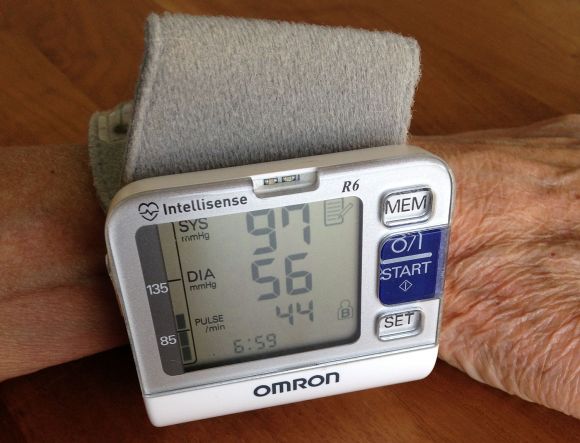
The monitor shown here can also save measurement values for two people. Here you can see my blood pressure and heart rate in the morning; I'm still half asleep, but also wide-awake and ready to start the day. As a result of eating primarily vegan raw food, my values have improved to the levels that athletes have (these values were from before I took up jogging). I work a double work week on my computer, even now that I am 77 years old. I do not have athletic heart syndrome.
Recommendations
And no matter how you are lying, your wrist is at about the same physical position as your heart. Try to always have your wrist in the same position when you do these measurements. The wrist cuff should be positioned so that nothing impedes accurate measurements.
You should use the other hand to turn the monitor on. In fact, that's the first thing that my hand automatically does in the morning, and I try to keep my head as empty as possible, but I like to listen to music—and only then do I activate the monitor. A healthy heart responds to every little thing. That's why I sometimes repeat the measurement a second time, especially if an unusual value is displayed. It does take a few minutes. It's also important to always use the same arm since for some people the two sides can have quite different values.

Here is an example from April 18, 2014, from 6:13 to 6:21 a.m.: 85/46 with a heart rate of 45, 79/44/42 and 79/43/43 with very little differences compared with the next morning at 7:15 a.m.: 107/48/53, 99/51/46, and 104/58/42. Something must have disturbed my sleep.
Even with the poorest values, I can spring out of bed and I feel fit and energetic.
My measurements during the day when I am in a sitting position are, for example: 129/75/42 and 133/75/47, but also 137/84/57 and 115/70/47.
Either I have a lower heart rate with much higher blood pressure or a higher heart rate with much lower blood pressure, for example: 115/67/53, 110/69/52, and 97/52/66.
I wanted to share these values with you so that you can see how different the values can be for the same person. The amount of water in the body plays a role here.
Pay more attention to the indulgence foods you consume, your eating behaviors, stress, signs of any sickness or inflammation, and the like.
Tobacco is something that we don't even need to discuss. With time, you will determine what is healthy for you and what isn't.
I can't tell if people who take medications can test their values in the same way because medications can change the values drastically. The lowest value upon waking isn’t used by physicians as this would only be possible in a hospital. It wasn’t always the case that monitors were so affordable and easy to use.
If you record your values a few times before changing your diet, you will be able to later see amazing changes. If you are going to take up a new sport, you should do this at another point in time, either quite a bit before or after you change your diet. Only this way will you be able to see the difference that your new diet has made.
I will explain the reasons for this in another section.
And as a result of taking these measurements, you will more clearly see the role that stress plays—and even more so any inflammations that you might have. Noticeable pus under a dead tooth can cause your resting heart rate to increase by 8 beats per minute. That is an increase of just over 15 %. If you are an older person who isn't very active, you can still achieve resting heart rates of between 40 and 50.
Our length and quality of life our not dependent only on the heart, but also on numerous other factors and organs. But there is a reason why the heart is the second most protected organ after the brain.
Also important to know is that it is estimated that the human heart consists of six billion heart muscle cells in the beginning with the number continually decreasing until a person has between two and three billion cells when they are older. It has recently been determined that a younger person can regenerate up to 1 % of the heart muscle cells, and an older person can still regenerate half of this number. But the heart can only recover between the beats. A low heart rate with blood pressure that isn't too high can therefore be beneficial in many ways.
5. Weight
You should also weigh yourself before you change your diet. Certainly, you already know how tall you are. I also suggest that you measure your waist in two different states. Energy is stored in the form of fat in your body in two harmless and necessary ways—and in one harmful way. The harmful type of fat storage is stomach fat.
This is why, medically speaking, the BMI (body mass index) and the WHR (waist-hip ratio) no longer play a significant role. Now it is your waist circumference that is important. I believe that this is better.
I assume here that the visceral fat can’t be displaced by sucking in your stomach and/or having your lungs filled to different capacities. This is entirely in contrast to gasses in your intestine and also stomach organs. In addition, older people often don't have the muscle tone that is needed for a strong core.
This is why I recommend that you measure your waist circumference at the position of your belly button after you have inhaled completely and stuck out your stomach (abdomen) Then measure again at the same position after you have exhaled completed and vigorously sucked in your stomach. This will show you the naked truth. Keep track of these values if you are overweight.
| The smaller the difference is between the total circumferences when you measure with your stomach sucked in and stuck out, the larger that the problem is. The medical field needs to use these as standard values. |
Your weight will automatically reset to its biological ideal value when you eat a raw food diet
A BMI of <18.5 is considered to be underweight, 18.5–24.9 normal weight, 25–29.9 overweight, 30–34.9 obesity class I, 35–39.9 obesity class II, and anything above this obesity class III.
And the other way around, if your BMI is 20 or below, I recommend that you switch to a strict vegan raw food diet and get regular check-ups. This warning might be unnecessary as numerous authors of raw food books claim, perhaps rightly so, that:
These authors emphasize the fact that individuals who are anorexic will gain weight until they reach their biological ideal weight. I don't want to accept this without being critical and only know that people who are overweight lose about 10 kg (22 lbs) within four to six months when they eat a vegan raw food diet.
Losing weight more quickly can be dangerous and lead to the yo-yo effect. If you are extremely overweight (obese), the results will be more substantial—at least losing a lot more over a longer period of time—until you achieve your biological ideal weight.
It is also important that you haven't had any major stomach or intestinal surgery. Your doctor can assess whether or not you will be able to tolerate a raw food diet. If the surgery was some time ago, you will have a sense of what you tolerate and what you don't. You should make the switch one step at a time.
In another section, you can read about the major differences regarding digestion. Do you suffer from allergies? These can also improve immensely when you switch over to a raw food diet. Beginning to eat a raw food diet rarely causes things to get worse as natural fruits and vegetables contain other substances than typical cooked foods. See the previous article and information here about energy balance.
Some people have allergies or intolerances to certain foods, for example, to certain types of fruit.
6. Existing illnesses
You must inform your physician about any significant illnesses or accidents you have had. He or she must have a clear picture of your health condition and know if you are taking any medications (drug products).
6.1. For diabetes
As a diabetic, you should be very careful as you change over to a raw food diet. Make sure that your blood sugar values stay in the normal range. When you are eating foods that are highly digestible, the burden on the pancreas won't be as high. But you should still use a glucose meter to regularly monitor your blood glucose.
If you choose the right raw foods, you can either reduce the number of injections or tablets, or in moderate cases, these can be eliminated altogether. It is always important to regularly monitor your blood sugar levels!
Valuable information about diabetes
You can read valuable information about diabetes on the Internet. Here is some of the most important information:
Wikipedia on blood sugar (German entry): In general, blood sugar refers to the amount of glucose (blood glucose level) present in the blood. Glucose is an important source of energy for the body. The brain, red blood cells, and renal medulla are dependent on glucose to produce energy; all other body cells produce energy primarily as part of lipid metabolism. Glucose is capable of passing the blood–brain barrier and, in this way, provides the brain with energy.
It is important to note that ketone bodies are also a major source of energy for the brain. Under brain: The behavior of the blood glucose level in hunger responses leads us to believe that a brain completely capable of breaking down ketone bodies prioritizes these (higher than glucose, even if there is a sufficient supply of glucose via the blood).
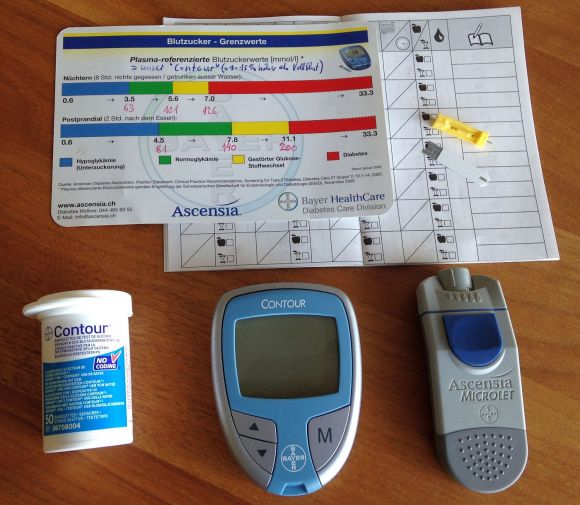
Wikipedia from April 2013 (German entry): In Germany, nearly 20% of the state health insurance budget is used to treat diabetes and its secondary and accompanying diseases. The costs for treating diabetes and its complications was about 25 billion euros in 2005. In 2010, this will increase to about 40 billion.
What do your values mean?
Under fasting conditions, normal values range from 70 to 100 mg/dL. Other sources list 60 mg/dL as the lower normal value. A fasting blood sugar value of 100–120 mg/dL is seen to be borderline and over 120 mg/dL is in the diabetic range.
If a person consistently has values of over 120 mg/dL, the diagnosis of diabetes is made. People without diabetes have a blood sugar value of under 110 mg/dL.
These somewhat low values should make it possible for type-2 diabetes to be diagnosed early in individuals who have borderline values. This way, they can still make changes to their diet and exercise before any complications occur. Complications of this type develop in the early stages of mild diabetes.
It is important to normalize your blood sugar level as early as possible since this will decrease the chances of complications. Since the food we eat has a significant impact on blood glucose levels, it is important to measure your blood sugar level under fasting conditions (if possible, 12 hours after your last meal).
The time since your last meal is very important. Why not go to the pharmacy a few times after you get up in the morning and before you have eaten to get your values checked? When you get a complete blood count done, every now and then, ask that your HbA1c value be checked (glycated hemoglobin, GHb).
This value shows whether your blood sugar was on average normal or high over the last three to four weeks. About one hour after a meal, the values reach their highest in the body, normally from 70 to 160 mg/dL and in borderline cases 200 mg/dL.
After eating a lot of pasta, a healthy person may also excrete glucose for a short period of time. If this occurs, a dangerous level has been exceeded. Two hours after eating, the value should go back down to 70 to 120 and shouldn't be higher than 150 mg/dL.
The islet cells in the pancreas produce "insuli.." and "I." antagonist, for example, glucagon. The pancreatic juice—about 1.5 liters per day—primarily contains enzyme precursors. These ensure that proteins, carbohydrates, and fats from our food can be absorbed by the blood.
The nutrient molecules in their normal form are much too large to enter the bloodstream. Enzymes in the pancreatic juice help to break down these molecules.
If you have a glucose imbalance, your doctor should rule out other diseases first.
And what if your blood sugar level is too high?
If you suspect diabetes mellitus, your physician will test for sugar in your urine. This will show up as soon as the individual renal threshold is exceeded. This test can be done using a test strip.
The glucose tolerance test is only recommended if diabetes is suspected. The patient eats a normal, carbohydrate-rich diet for three days and does the same physical activities as usual.
After these three days, the patient is given 300 mL of water containing 75 to 100 mg of dissolved sugar in the morning under fasting conditions. The blood sugar level is tested before this.
Two or three hours after the “sugar cocktail,” measurements two and three are then taken. The values obtained reveal cases of hidden diabetes.
The WHO no longer divides diabetes mellitus into two groups, but rather into four groups with various subgroups of causes.
Possible causes are excessive hygienic care as a baby, changing from breastfeeding to dairy milk before the end of the second month, toxins in the form of hazardous substances and medications, and virus infections such as the Coxsackie Virus.
Type-2 diabetes is very different from type-1 diabetes. With type 1, the "insul.." production decreases steadily until the insulinproducing cells are completely destroyed. With type 2, there is too much "I." in the bloodstream, therefore the exact opposite.
With type-2 diabetes, the pancreas produces an increasing amount of "I." over time because the cells no longer respond to "I.". The cells build up a resistance.
Genetics increases the risk for type 2 considerably. It is my assumption that it is not completely clear whether the “genetics” come from the “eating habits” causing a change through epigenetics or if they come from the gene pool itself (as of 2001).
But the results are the same. However, with type-2 diabetes, genetic predisposition plays a much greater role than with diabetes type 1.
The probability of getting diabetes type 2 as an adult is 40 % if one parent had type-2 diabetes, and 60 % if both parents had type-2 diabetes.
Adiposity is a medical term for obesity, and hypertension (HTN or HT) is synonymous with high blood pressure and arterial hypertension.
In the case of "I." resistance, glucose is not able to move from the blood into the cells. Normally, "I." opens the cells for glucose. But with the increasing resistance, an ever decreasing number of cells take up glucose.
Glucose then circulates at higher levels in the bloodstream as "I." is not able to work effectively. The body interprets this as an “insulindeficiency” (although there is actually enough there) and gives the signal to produce even more "I.".
This increased production causes the "I." level to increase further in the blood, which is a process called hyperinsulinism.
Diabetes mellitus type 2 (previously II) and a decreased glucose tolerance, arterial hypertension, lipid metabolism disorders, obesity, and coronary heart disease frequently manifest in the same person. Decreased glucose uptake in the absence of insulinstimulation is the root of the problem here.
This is a metabolic syndrome. It is too often the case that type-2 diabetes is diagnosed too late, for example, between the ages of 55 to 60. At this point, initial complications are sometimes already present. Eighty percent of those who get type-2 diabetes are significantly overweight.
Apart from that, there are groups that have this genetic risk as a result of the eating habits of the older generation. Epigenetics has not yet received enough attention in practice.
Patients usually don't know what they will face with diabetes when they are older—even if they have had a positive outlook for decades. This is because the side effects that accumulate from treating the symptoms also play an important role. After all, it is the patients' intelligence that will determine how long their brain keeps up and how long they can lead a relatively normal life because every abnormal blood sugar level destroys cells, including brain cells.
I know diabetics who take something every two hours, almost to the minute and calculated precisely. Conventional treatment, that is only treating the symptoms, can keep patients going for a relatively long time. Continuous glucose monitoring with an insulinpump is also a good possibility. This allows patients to avoid hypoglycemia and its dangerous complications.
Today's young people are eating a lot of fast food, and as a result, an increasing number of people are getting diabetes at a relatively young age and suffering the consequences. A radical change in diet can have a major effect, a curative one.
6.2. High blood pressure (hypertension)
Professor John B. Kostis, Robert Wood Johnson Medical School, in New Jersey, United States, presented a meta study at the nineteenth congress of the European Society for Cardiology in Stockholm that was based on studies of left ventricular dysfunction (SOLVD).
In connection with the medical and economic implications of treating high blood pressure, the analysis of this investigation resulted in amazing findings.
With over 100 million people in Europe who have high blood pressure, Prof. Kostis, is right to question the medical expenditures incurred in the context of this lifestyle disease.
Heart attacks, heart failure, and strokes are almost inevitable consequences of untreated high blood pressure. The alarming high mortality rate of this disease forces us to act since waiting out the problem could increase the subsequent costs so much that these would by far surpass the money saved in the short term.
The underlying causes aren't being addressed, and only the symptoms are being treated
What was just said in two sentences gives us an idea of the suffering caused by high blood pressure. Unfortunately, a person who is sick doesn't usually notice anything unusual.
And doctors often do an echocardiogram (echocardiography, cardiac echo), an EKG (electrocariography), and, where necessary, long-term EKG monitoring and a stress test and can't find any physical or psychological reason for the high blood pressure. They then diagnose it as essential hypertension.
In other words, Kostis means that this is just the situation right now. Depending on the age and severity of the case, patients are prescribed beta-blockers or ACE inhibitors. The underlying causes aren't being addressed, and only the symptoms are being treated.
If your doctor is particularly good, he or she will warn you of the side effects and will give you some rules of thumb to follow. Later, you might be “allowed” to take both drugs at the same time. The pharmaceutical industry appreciates this.
Antihypertensive drugs such as ACE inhibitors, angiotensin II receptor antagonists, beta-blockers, diuretics, and calcium channel blockers bring in billions in profit.
However, a doctor would just have to refer patients to this text—and then the responsibility would be in the hands of the patients. At least, they would then have the chance to get their problems under control. I believe that regular physical examinations are important; otherwise, the process is counterproductive.
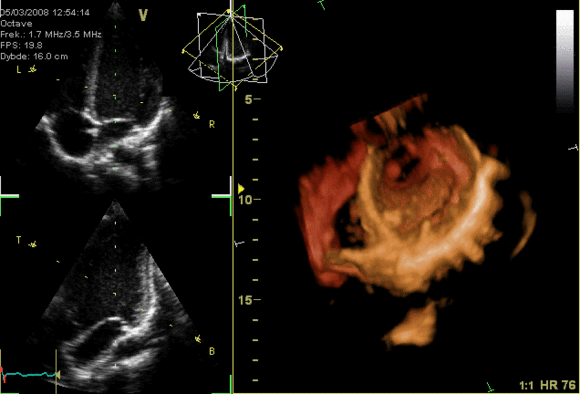
Original text: 3D reconstruction of the heart as viewed from the apex towards the valves, image flipped 180° relative to illustration above. Pulmonary valve not visible, leaflets of the tricuspid and aortic valves only partly visible. To the left two images in 2D from the same dataset, showing tricuspid and mitral valves (above) and aortal and mitral valve (below).
Even with chronic hypertension, numerous cases have been cured by a long-term raw food diet that is line with the above factors. Most professors in this field don't even know this.
6.3. Gout (hyperuricemia)
Gout is no longer known as a “rich person's disease.” Today, almost everyone can afford animal-based products in abundance. In connection with abnormal uric acid excretion, these cause this purine metabolic disease.
One to two percent of Central Europeans currently have this disease that is accompanied by chronic joint pain. There are now various medications that can be used to successfully treat gout.
However, diet changes should always be at the center of any treatment. This is recommended by the medical community.
A distinction is made between primary and secondary gout. Secondary gout is rare, but people sometimes develop gout as a result of various types of leukemia, chronic renal disease, diuretic medications, or means to treat cancer.
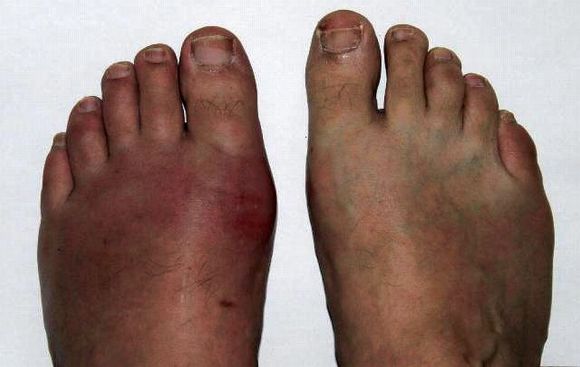
The only way to avoid taking medications is to make major changes to your lifestyle
The first gout attack often comes during the night. Typically, a person then wakes up with extreme pain in their big toe (podagra). The joint swells and becomes red, and the pain is unbearable. The pain usually begins at night or early in the morning. Normal movement is made difficult.
People often have pain in other joints such as the shoulder (omagra), wrist (chiragra), or knee (gonagra). If the uric acid levels are significantly high, it may be necessary to take medications for life. Deposits of uric acid crystals (urate deposits) cause the pain. Gout can cause bone resorption and damage to cartilage. Chronic kidney disease is ultimately the result of severe gout over a long period of time.
"Allopurin.." is one of the most common medications that are prescribed.
This is why a number of guidebooks don’t only explain in detail how gout develops and how it can be treated with medications, but also provide extensive help with planning a healthy menu, including numerous recipes.
A raw food diet can be even more effective!
To summarize, gout is caused by a purine-rich diet along with a genetic predisposition, and it is often linked to excess weight, which for men in their middle ages especially leads to problems.
But gout can also occur as a result of strict fasting (limited time frame), high alcohol consumption, or taking certain medications—for example, medications taken for renal excretion disorders.
When you are on a strict diet for fasting, your body lives off of its stores. The numerous ketone bodies that are produced inhibit the excretion of uric acid via the kidneys temporarily.
Gout as a purine metabolic disease
Dr. Christian Rous describes gout as a purine metabolic disease characterized by increased uric acid levels in the blood that lead to deposits of uric acid crystals in the joints and tissues.
If the uric acid level is over a specific value (6.4 mg/dL), this is called hyperuricemia (Greek: “too much uric acid in the blood”). Rous continues, The elevated uric acid values do not have to lead to gout—they simply represent the biochemical basis. However, elevated uric acid concentrations increase the probability of a gout attack.
The value of 6.5 mg/dL listed above is the upper limit above which precipitation of uric acid crystals and deposits in the joints and in the tissue can occur. This then leads to the painful symptoms characteristic of a gout attack.
Healthy individuals have a balance between the consumption of uric acid (via the purines present in food) and the production of uric acid by the body on the one hand, and the excretion of uric acid on the other. Based on a wide range of causes, this balance is disrupted in people suffering from gout.
People who are overweight or suffer from lipid metabolism disorders, diabetes, or high blood pressure are affected much more often by gout. The development of hyperuricemia is influenced by excess weight, high alcohol consumption, and a diet rich in purines.
Dietary recommendations exhort us to do the following: Say no to every excess calorie. Eat a lot of vegetables, fruit, potatoes, and grains (whole grain products).
If a person who has gout and is also overweight achieves a normal body weight, this will often be enough to reduce the elevated uric acid level (hyperuricemia).
A vegan raw food diet offers you the greatest chances of recovery. But with gout, you need to avoid the following foods: spinach, asparagus, cauliflower (white, orange, Grafitti, Purple Head, and Romanesco), legumes (peas, lentils, and beans—the latter should only be part of a cooked foods diet), soy products, peanuts (also raw), and fat.
A person suffering from gout should try to avoid alcohol as much as is possible because alcohol promotes the production of lactic acid, which leads to hyperacidity of the blood. This lowers the solubility limit of uric acid, promoting a crystallization of uric acid crystals.
In addition, alcohol inhibits uric acid excretion via the kidneys and stimulates endogenous uric acid synthesis. Beer (especially dark beer) also contains purines, which increase the uric acid level in the body. The combination of alcohol consumption and a high-fat diet is particularly problematic.
6.4. Basal temperature test measures thyroid function
It seems that an underactive thyroid (hypothyroidism) is quite common, but severe hypothyroidism (myxedema) is actually very rare. An underactive thyroid causes a person to have low energy levels. Anemia or lymph stasis (blockage), respiratory and urinary tract disorders, and migraines can also occur.
In any case, body temperature tends to be lower, and the circulation of the extremities, such as the hands and feet, is poor. An excellent summary of endocrinology—the inner secretion or rather production and mode of action of hormones—is available at medizinfo.com/endokrinologie (German only).
Thyroid
This website is a source of a lot of valuable information and is one of the best sites to go to for general medical questions. The following passage about the thyroid, which is about 20 grams, comes from this site:
Without the hormones produced by the thyroid, not a lot would function in the human body. The heart rate and strength of the heart, body temperature, energy metabolism of cells, work of the skeletal musculature, growing and maturation of the CNS, all of these things are regulated with the help of thyroid hormones. If too many or too few hormones are available, a variety of syndromes can develop.
Only for readers who want to know more: the thyroid is located in front of the esophagus. It is primarily responsible for producing thyroid hormones, the main ones being thyroxine (T4) with four iodine atoms and triiodothyronine (T3) with three iodine atoms (iodine).
The release of T3 and T4 regulates a feedback look with the hypothalamus, which releases TRH (thyrotropin-releasing hormone). The neuropeptide TRH causes the pituitary gland to then release TSH (thyroid-stimulating hormone). TSH ultimately regulates the production and release of T3 and T4.
The C-cells in the thyroid also produce calcitonin, which regulates calcium metabolism. The antagonistic hormone, the parathyroid hormone, is produced by the parathyroid glands. The parathyroid hormone stimulates the production of active vitamin D.
Calcitonin inhibits intestinal calcium absorption and ensures that more calcium and phosphate are incorporated into the bone substance and that the kidneys reduce the calcium levels in the blood.
What is the medical opinion on the symptoms caused by an underactive thyroid?
When few or no hormones are released by the thyroid, this leads to decreased metabolism. The extent of this is dependent on the degree of severity, the length of the hormone deficiency, the person's age when the disease began, and any accompanying diseases. Not everyone will develop all of these symptoms.
The main symptoms are as follows: increased fatigue, general weakness, constant feeling of freezing, inability to tolerate cold, inability to sweat, lack of interest, difficulty concentrating, angina pectoris problems, poor circulation, headaches, impotence, hair loss, numbness in the fingertips, rheumatic disorders, and difficulty breathing.
An iodine deficiency is capable of causing an underactive thyroid. With a sufficient supply of iodine, the thyroid has stores for about three months. Germany, Austria, and Switzerland have a lower presence of iodine in the soil due to erosion caused by glacial water.
This is one reason why it is important to have blood tests done before you change your diet. A physician will most likely have a TRH test (thyreoliberin) done. The TSH value in your blood is measured, 200 milligrams of TRH are then injected into a vein, and after 30 minutes the TSH value is tested again.
There should be an increase of more than two microE/mL. According to Gray, individuals with excessive or chronic mucus often suffer from an underactive thyroid. If the increase doesn't occur, you can decrease mucus production by changing your diet.
| An analog basal thermometer, and a digital version. Images of specific brands. | |
Gray also writes that an underactive thyroid can be detected by measuring your basal body temperature. This is the temperature that is measured immediately after you wake up and before you move around, and is the lowest temperature that the body has during the time that you are awake.
A basal thermometer can also be used to determine a woman's date of ovulation. But a method that is much simpler than Gray's is to measure your temperature using an electronic thermometer. Just turn the thermometer on, place it under your tongue, and wait until you hear a beep. This only takes one to one and a half minutes.
Measuring your basal body temperature
Gray explains the following method quite meticulously: right after you wake up and without getting up or having to reach very far, put the thermometer under one side of your tongue. Lie still for seven minutes—if possible, with your eyes shut. Then move the thermometer to the other side of your tongue and read your temperature after an additional three minutes. Increments of 0.05 degrees Celsius should be visible.
During this time, you should in no case sit up, move, drink anything, or talk because your temperature would then immediately increase and you wouldn't be able to get a reading of the basal value. Omit all values that seem questionable. You need about ten accurate measurements.
Women should measure their basal temperature from the beginning of their period to the day before ovulation as the basal temperature sinks to its lowest value at ovulation and in the few days afterward increases by one to two degrees.
The normal basal temperature under the tongue is between 36.5 and 36.8 degrees in humans.
In the case of an underactive thyroid, the body temperature tends to fluctuate considerably, but generally remains under 36.5 degrees. A temperature change of one degree changes the metabolic rate by about 18%
[249–70]
The basal thermometer made by Uebe Medical GmbH is a good example. This somewhat expensive thermometer has a red arrow in the middle of the readout scale that marks the midpoint of 36.9 degrees. Six graduation marks with numbers show 1/10 degrees.
This thermometer only has a readout range of 1.2 degrees and is therefore not suitable to use as a fever thermometer. The readout range is distributed over 5.7 cm. The graduation marks without numbers show 1/20 degrees.
After you use the thermometer, you should, of course, “shake it down.”
Only about one percent of the cases with values that are too low point to underactive pituitary or adrenal glands.

In my case, my first measurement showed 35.8 degrees with a blood pressure of 100 over 61 and a heart rate of 49. This can't even be read using a basal thermometer.
My wife, however, had a temperature reading of 36.9 degrees with a blood pressure of 99 over 63 and a heart rate of 47. Nota bene: Before she started to eat a raw food diet, she was diagnosed with essential high blood pressure.
It's Sunday, 5:30 a.m., and I am full of energy and ideas and start with my work. Kathrin asks me to turn off the alarm (I don't need one) so that it doesn't go off at 8 a.m. People can be this different even if they have the same daily routine and habits.
Here's my conclusion: unfortunately, I don't know what my basal temperature and blood pressure / heart rate were before I changed to a raw food diet. I am only astonished to discover that according to medical standards, someone with my values should have a poor state of health.
You would think that my cholesterol values would be high as well, but the opposite is the case at 3.0 mmol/L (LDL = 1.6). Between the two of us as partners, we should have the exact opposite state of health.
However, in 2001, I had been eating a raw food diet for several years, whereas my wife (then my life partner) had only been eating a raw food diet for a few months. But we should really be able to objectively assess the results that a strict raw food diet has on every single person.
What were your values before and after changing over to a raw food diet and what was your state of health before and after?

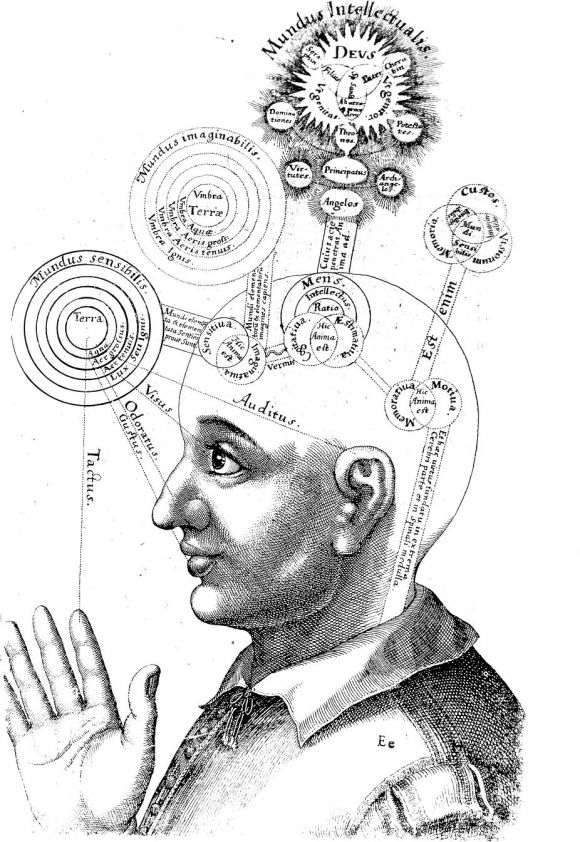

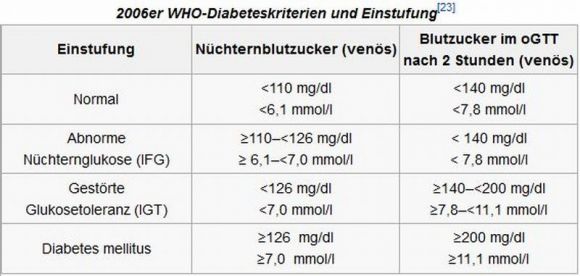


Comments